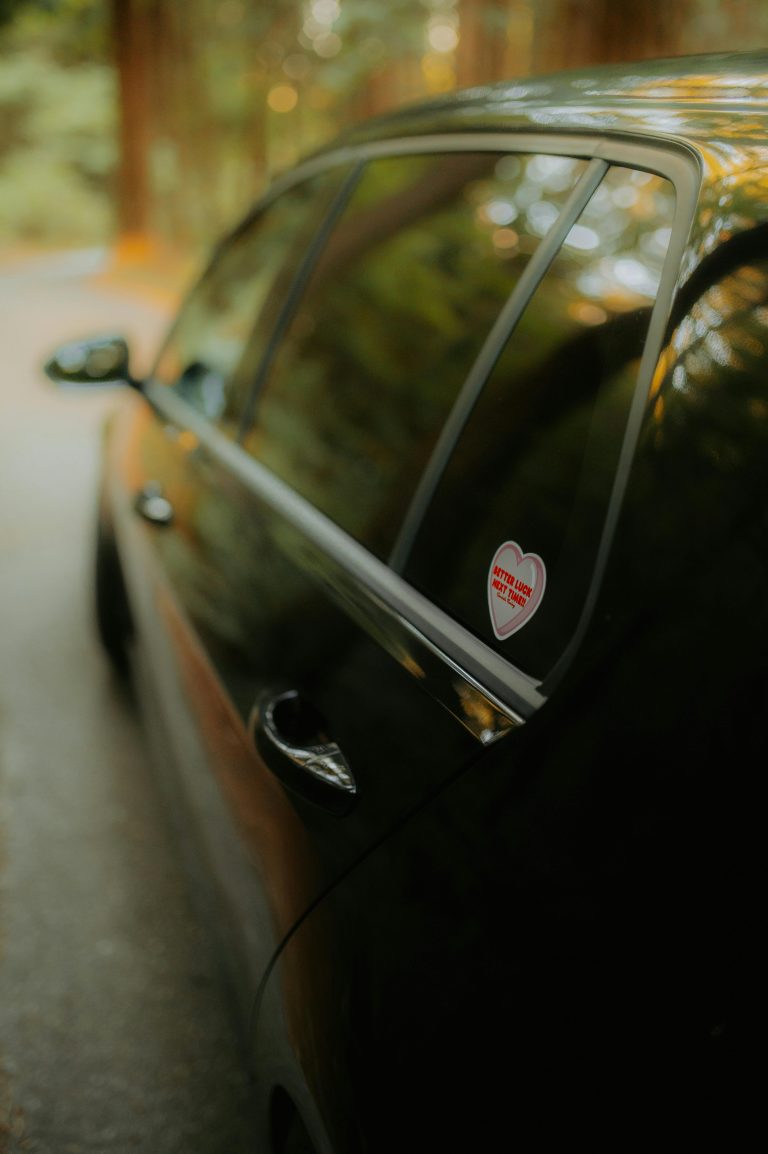Protect Your Car's Interior With Quality Tint

When you think about your car’s interior, you might not realize how much damage sun exposure can cause over time. Quality tint isn’t just an aesthetic choice; it plays a crucial role in protecting your upholstery and dashboard from fading while also enhancing comfort on hot days. With so many options available, including ceramic and carbon tints, knowing which one suits your needs can be daunting. But before you decide, it’s important to consider a few key factors that could make all the difference in your vehicle’s longevity and your driving experience.
How Quality Tint Protects Your Car's Interior
Protecting your car’s interior starts with choosing quality tint. A premium window film offers UV protection, blocking up to 99% of harmful rays. This is crucial, as prolonged exposure can cause significant damage, leading to color fading of your upholstery and dashboard.
By investing in quality tint, you’re not just enhancing your car’s aesthetics; you’re also preserving its interior.
Heat reduction is another benefit you’ll appreciate. Quality tint keeps your car cooler during hot summer days, which means you won’t have to crank up the air conditioning as much. This not only improves your comfort but also helps in reducing fuel consumption.
Additionally, glare reduction is vital for safe driving. Quality tint minimizes harsh sunlight, allowing for a clearer view of the road without straining your eyes. This can make your driving experience much more enjoyable and safer.
Types of Car Window Tinting
When it comes to car window tinting, understanding the different types available can help you make an informed choice. Each type has its unique benefits and drawbacks, catering to different needs and preferences.
Here’s a quick overview:
- Dyed Tint: This is the most basic option, where dye is applied to a layer of film. It provides a sleek look and reduces glare but offers minimal heat rejection.
- Metallic Tint: This tint contains tiny metallic particles, reflecting heat and UV rays effectively. However, it may interfere with electronic signals, such as GPS.
- Ceramic Tint: Known for its superior heat rejection and UV protection, ceramic tint doesn’t fade over time and doesn’t interfere with signals, making it a popular choice.
- Carbon Tint: This is a step up from dyed tint, providing better heat rejection without the reflective qualities of metallic tint.
- Hybrid Tint: Combining elements of dyed and metallic tints, hybrid tint offers good heat rejection and a stylish appearance.
Choosing the right tint can enhance comfort and protect your car’s interior, so consider these options carefully!
Legal Considerations for Window Tinting
Understanding the legal considerations for window tinting is crucial before you make any decisions. Each state has its own tinting regulations, which dictate the legal limits for how dark or reflective your window tint can be. These laws can vary significantly, so it’s essential to familiarize yourself with your state’s specific requirements.
Most states have established legal limits on the Visible Light Transmission (VLT) percentage, which indicates how much light can pass through the tinted windows. If your tint exceeds these limits, you could face penalties, including fines or being required to remove the tint altogether.
Tint enforcement can be strict, as law enforcement officers often perform compliance checks to ensure vehicles adhere to state laws. Before investing in window tinting, check your local regulations to avoid any hassles later on.
Some states even require a sticker on your tint to indicate compliance. By staying informed and compliant with the legal limits, you can enjoy the benefits of tinted windows without the stress of potential legal issues. This proactive approach ensures your car remains stylish and comfortable, all while staying within the law.
How to Choose the Right Tint for Your Vehicle
After ensuring your window tint complies with local laws, the next step is selecting the right tint for your vehicle. With various options available, it’s essential to consider factors that will enhance your driving experience while protecting your car’s interior.
Here are three key considerations:
- Tint Shade Options: Choose from a range of shades to balance aesthetics and visibility. Darker tints provide more privacy but may reduce nighttime visibility.
- UV Protection Benefits: Look for tints that offer high UV protection. These films can block up to 99% of harmful rays, protecting your skin and preventing your interior from fading.
- Cost Considerations: Weigh the price against the benefits. Higher-quality tints may cost more upfront but often offer better durability and effectiveness, leading to long-term savings.
Additionally, an installation techniques overview can help you decide whether to go professional or consider a DIY approach.
A tint effectiveness comparison can also guide you in making an informed choice.
Take your time to evaluate these factors, and you’ll find the perfect tint for your vehicle.
Professional vs. DIY Tinting: What's Best?
Choosing between professional installation and a DIY approach for window tinting can feel overwhelming, but weighing the pros and cons of each option will help you make the best decision for your vehicle.
When considering cost comparison, DIY tinting often appears more budget-friendly. However, think about the potential expenses tied to common mistakes, like misalignment or air bubbles, which can lead to needing a professional re-do.
Professional installers typically use advanced installation techniques that ensure a flawless finish and better longevity factors for the tint. Their expertise means they’re less likely to make errors that could compromise your tint’s effectiveness.
Moreover, expert recommendations often highlight that professional tinting can enhance the overall aesthetic appeal of your car. The materials they use are usually of higher quality, offering improved UV protection and durability.
While DIY kits might seem tempting, they often don’t match the longevity and performance of professionally applied tints.
Ultimately, the decision hinges on your budget, skill level, and how much you value the long-term benefits of quality installation. Weighing these aspects will guide you toward the best choice for your vehicle’s window tinting needs.
Maintenance Tips for Long-Lasting Tint
To keep your car’s tint looking great for years, a few simple maintenance tips can go a long way. Proper tint care not only enhances the aesthetics of your vehicle but also maximizes UV protection and heat reduction.
Follow these key maintenance practices to ensure longevity:
- Use Gentle Cleaning Techniques: Always use a soft microfiber cloth and a pH-balanced cleaner when cleaning your tinted windows. Avoid abrasive materials that can scratch the film.
- Avoid Extreme Temperatures: Try to park your car in shaded areas or use a sunshade to minimize heat exposure. Excessive heat can damage the tint, affecting its appearance and performance.
- Don’t Roll Down Windows Immediately: After having your windows tinted, resist the urge to roll them down for at least a week. This allows the adhesive to cure properly, which is crucial for longevity factors.
Frequently Asked Question
How Long Does Window Tint Typically Last?
- Window tint typically lasts 5 to 10 years, depending on tint longevity factors like quality and care. Regular maintenance enhances UV protection benefits and heat reduction effectiveness, while exploring tint warranty options can ensure lasting satisfaction.
Can Window Tinting Improve Privacy Inside the Car?
- Yes, window tinting can significantly improve privacy inside your car. The tint darkness aids in security enhancement, while also providing privacy benefits, heat reduction, and glare reduction, making your driving experience more comfortable and secure.
Will Tinting Affect My Car’s Resale Value?
- Yes, tinting can positively affect your car’s resale value. Tint benefits like enhanced privacy can appeal to buyers. Professional installation aligns with market trends, improving consumer perceptions and potentially leading to a higher resale impact.
Is Window Tinting Safe for All Vehicle Types?
- Window tinting’s safe for most vehicles, but check legal tint limits in your area. You’ll enjoy heat reduction effectiveness and UV protection advantages, plus various installation methods can suit your preferences and needs.
Can I Remove Window Tint Myself?
- Yes, you can remove window tint yourself using DIY tools and various removing methods. However, be cautious of adhesive residue. If unsure, seeking professional assistance might save you time and ensure a cleaner finish.
Conclusion
In conclusion, investing in quality window tint for your car is a smart move to protect your interior and enhance comfort. By blocking harmful UV rays and reducing heat, you can keep your vehicle looking great and feeling cool. With various tint options available, it’s essential to choose the right one for your needs. Whether you go professional or DIY, proper maintenance will ensure your tint lasts, allowing you to enjoy the benefits for years to come.
